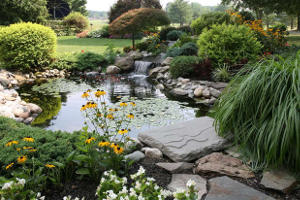5 Basic Stepping Stones to Water Features
See if We Have Top-Rated
Landscaping Contractors in Your Area

Landscaping is a great way to add some curb appeal to your home, thereby increasing its overall value. When sprucing up your yard, there are some essentials to keep in mind. You should always install a patio, put in some native plants, and an irrigation system is never a bad idea. But it never hurts to give your exterior a dramatic makeover, and sometimes a flowerbed or garden just isn't enough. If you have a green thumb and like to spend time in your yard, then a new water feature may be just the thing to add some life to your landscape. Here are 5 basic steps that will prepare you to make the right decision.
Step #1: Sound Selection
First off, what is your intention? Do you want a tranquil pond that will soothe away your worries? A zen-like garden pond or a bubbling brook? Or do you want something a bit more theatrical, such as a splashing waterfall or flowing fountain? Answering these questions will help you determine the size and power of your water feature. Creating a raging river in your backyard will take up more space and increase the cost, but it may also mask the bark of a neighbor's dog or the traffic of a nearby street. On the other hand, a little can go a long way, so installing a small bubbler, lagoon, or grotto may be enough to create a peaceful retreat without overwhelming the landscape (or your wallet).
Step #2: Aquatic Appearance
Next, you should think about appearances. Remember, a water feature can be anything aquatic. It can be as simple as a birdbath, bubbler statues, or potted fish bowls, each of which creates an opportunity to add a little wildlife to your oasis. Or it can be a pond equipped with spurting fountains, floating lily pads, and stream beds. They can even span to larger creations, such as rock-lined pools or waterfall spas. First, decide if you want an above-ground or in-ground addition. An above-ground unit brings things closer to eye-level, are easier to install, and can be a bit cheaper, though they're also louder and are vulnerable to weather problems. In-ground units are naturally insulated by the soil and don't freeze up as much, but they take a bit more digging and manipulating. It may be best to consult a landscape architect who can not only lead you to the right decision but help with the final water feature installation as well.
Step #3: Proper Placement
Matching a model with the rest of your yard is crucial. First off, think about where to locate it. The front yard is a great way to add curb appeal and attract immediate attention, but most homeowners don't spend much time on the front porch. So, though hidden from view, the backyard is probably better since it gives you more room to work around. Second, think about placement. Is it to be a focal point or an accent? When positioning, it's best to avoid other foliage (such as under trees) so as to avoid any falling leaves, debris, or clogs. Also, if you install a fountain, you'll want to think about its exposure to the wind and other elements. Third, make sure it matches your yard. Does the plant life gel with the size and function of the water feature? Is it being used to circulate a pool or is it just for looks? What about the other landscaping (bridges, foot paths, and lighting) to highlight the unit? Each decision will bring you closer to your ideal choice.
Give your yard a unique look! Use this link to
Install Water Feature
Step #4: Water Feature Installation
Though many come in do-it-yourself kits, these additions come with lots of working parts, such pumps, liners, filters, aerators, piping, and motors. Plus, they can come in stone, concrete, metal, wood, or a mixture of materials. Therefore, it may be a good idea to hire a professional landscaper to install the unit for you. What's more, these experts can also work around any utility, cable, or electrical wiring, and they can obtain permits if needed. They can also give you tips about selection, maintenance, and usage. For instance, if you want to erect a giant rock formation around your pool, these contractors can possibly suggest faux rocks that can have the same appearance and texture as stone but is lighter, cheaper, and easier to install.
Step #5: Pricing Philosophy
Remember, bigger isn't necessarily better. When remodeling, only a small portion of your budget should go towards landscaping since it doesn't always guarantee a return on your investment. Therefore, even less money should be allotted to luxury items. So when it comes to water feature installations, it may be best to think small and subtle as opposed to bigger than life. And costs can add up quickly considering all their parts, equipment, and mechanisms. So don't get swept away by the moving water. Instead, remain focused and make your decisions based on value rather than extravagance.

